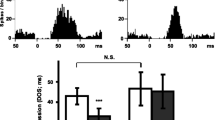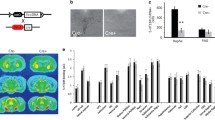Abstract
Rationale
Venlafaxine is a non-selective serotonin and noradrenaline reuptake inhibitor antidepressant drug for which clinical studies have suggested a high level efficacy and a possible early action onset compared to the classical antidepressants. Its therapeutic effects might be due, at least in part, to adaptive changes in serotonergic neurotransmission, through the activation of the different 5-HT receptor subtypes. 5-HT1B receptors are located in the axon terminals of both serotonergic and non-serotonergic neurons, where they act as inhibitory autoreceptors or heteroreceptors, respectively. However, the information about the involvement of this subtype in the mechanism of action of antidepressants is limited and quite controversial.
Objectives
The aim of this study was to evaluate the effect of venlafaxine (10 mg kg−1 day−1, p.o.) after 21 days of treatment on the density of 5-HT1B receptors and their functionality in rat brain.
Methods
Effects of chronic venlafaxine were evaluated at different levels of 5-HT1B receptor by using receptor autoradiography, [35S]GTPγS binding, and the regulation of body temperature induced by selective 5-HT1B agonist.
Results
Our results show that venlafaxine induced an increase in sensitivity of 5-HT1B receptors in hypothalamus both at G-protein level and the control of core temperature without affecting the receptor density.
Conclusions
These results demonstrate that adaptive changes on 5-HT1B receptors induced by chronic administration of venlafaxine exhibit regional differences suggesting that the hypothalamus might be an important site of drug action.





Similar content being viewed by others
Abbreviations
- 5-HT:
-
5-Hydroxytryptamine serotonin
- NSRI:
-
Serotonin and noradrenaline reuptake inhibitor
- SSRI:
-
Selective serotonin reuptake inhibitor
- HPA:
-
Hypothalamic–pituitary–adrenocortical
References
Adell A, Castro E, Celada P, Bortolozzi A, Pazos A, Artigas F (2005) Strategies for producing faster acting antidepressants. Drug Discov Today 10:578–585. doi:10.1016/S1359-6446(05)03398-2
Arborelius L, Owens MJ, Plotsky PM, Nemeroff CB (1999) The role of corticotropin-releasing factor in depression and anxiety disorders. J Endocrinol 160:1–12. doi:10.1677/joe.0.1600001
Artaiz I, Zazpe A, Innerarity A, Del Olmo E, Diaz A, Ruiz-Ortega JA, Castro E, Pena R, Labeaga L, Pazos A, Orjales A (2005) Preclinical pharmacology of F98214-TA, a novel potent serotonin and noradrenaline uptake inhibitor with antidepressant and anxiolytic properties. Psychopharmacology (Berl) 182:400–413. doi:10.1007/s00213-005-0087-3
Auerbach SB, Hjorth S (1995) Effect of chronic administration of the selective serotonin (5-HT) uptake inhibitor citalopram on extracellular 5-HT and apparent autoreceptor sensitivity in rat forebrain in vivo. Naunyn Schmiedeberg´s Arch Pharmacol 352:597–606. doi:10.1007/BF00171317
Barden N, Reul JM, Holsboer F (1995) Do antidepressants stabilize mood through actions on the hypothalamic–pituitary–adrenocortical system? Trends Neurosci 18:6–11. doi:10.1016/0166-2236(95)93942-Q
Bauer M, Tharmanathan P, Volz HP, Moeller HJ, Freemantle N (2009) The effect of venlafaxine compared with other antidepressants and placebo in the treatment of major depression: a meta-analysis. Eur Arch Psychiatry Clin Neurosci 259:172–185. doi:10.1007/s00406-008-0849-0
Béïque JC, Lavoie N, de Montigny C, Debonnel G (1998) Affinities of venlafaxine and various reuptake inhibitors for the serotonin and norepinephrine transporters. Eur J Pharmacol 349:129–132. doi:10.1016/S0014-2999(98)00241-6
Béïque JC, de Montigny C, Blier P, Debonnel G (2000a) Effects of sustained administration of the serotonin and norepinephrine reuptake inhibitor venlafaxine: I. In vivo electrophysiological studies in the rat. Neuropharmacology 39:1800–1812. doi:10.1016/S0028-3908(00)00017-4
Béïque JC, de Montigny C, Blier P, Debonnel G (2000b) Effects of sustained administration of the serotonin and norepinephrine reuptake inhibitor venlafaxine: II. In vitro studies in the rat. Neuropharmacology 39:1813–1822. doi:10.1016/S0028-3908(00)00018-6
Blier P, Chaput Y, de Montigny C (1988) Long-term 5-HT reuptake blockade, but not monoamine oxidase inhibition, decreases the function of terminal 5-HT autoreceptors: an electrophysiological study in the rat brain. Naunyn Schmiedeberg´s Arch Pharmacol 337:246–254. doi:10.1007/BF00168834
Bolaños-Jiménez F, Manhães de Castro R, Fillion G (1994) Effect of chronic antidepressant treatment on 5-HT1B presynaptic heteroreceptors inhibiting acetylcholine release. Neuropharmacology 33:77–81. doi:10.1016/0028-3908(94)90099-X
Boschert U, Amaram DA, Segu L, Hen R (1994) The mouse 5-hydroxytryptamine1B receptor is localized predominantly on axon terminals. Neuroscience 58:167–182. doi:10.1016/0306-4522(94)90164-3
Bosker FJ, van Esseveldt KE, Klompmakers AA, Westenberg HG (1995) Chronic treatment with fluvoxamine by osmotic minipumps fails to induce persistent functional changes in central 5-HT1A and 5-HT1B receptors, as measured by in vivo microdialysis in dorsal hippocampus of conscious rats. Psychopharmacology (Berl) 117:358–363. doi:10.1007/BF02246110
Bramley JR, Sollars PJ, Pickard GE, Dudek FE (2005) 5-HT1B receptor-mediated presynaptic inhibition of GABA release in the suprachiasmatic nucleus. J Neurophysiol 93:3157–3164. doi:10.1152/jn.00770.2004
Bruinvels AT, Palacios JM, Hoyer D (1993) Autoradiographic characterisation and localisation of 5-HT1D compared to 5-HT1B binding sites in rat brain. Naunyn Schmiedeberg´s Arch Pharmacol 347:569–582. doi:10.1007/BF00166939
Castro ME, Díaz A, del Olmo E, Pazos A (2003) Chronic fluoxetine induces opposite changes in G protein coupling at pre and postsynaptic 5-HT1A receptors in rat brain. Neuropharmacology 44:903–101. doi:10.1016/S0028-3908(02)00340-4
Castro E, Díaz A, Rodríguez-Gaztelumendi A, del Olmo E, Pazos A (2008) WAY100635 prevents the changes induced by fluoxetine upon the 5-HT1A receptor functionality. Neuropharmacology 55:1391–1396. doi:10.1016/j.neuropharm.2008. 08.038
Chaput Y, de Montigny C, Blier P (1986) Effects of a selective 5-HT reuptake blocker, citalopram, on the sensitivity of 5-HT autoreceptors: electrophysiological studies in the rat brain. Naunyn-Schmiedeberg´s Arch Pharmacol 333:342–348. doi:10.1007/BF00500007
Chenu F, David DJ, Leroux-Nicollet I, Le Maitre E, Gardier AM, Bourin M (2008) Serotonin1B heteroreceptor activation induces an antidepressant-like effect in mice with an alteration of the serotonergic system. J Psychiatry Neurosci 33:541–550
Clark MS, Neumaier JF (2001) The 5-HT1B receptor: behavioral implications. Psychopharmacol Bull 35:170–185
Coppen A (1967) The biochemistry of affective disorders. Br J Psychiatry 113:1237–1264. doi:10.1192/bjp.113.504.1237
Doménech T, Beleta J, Palacios JM (1997) Characterization of human serotonin 1D and 1B receptors using [3H]-GR-125743, a novel radiolabelled serotonin 5HT1D/1B receptor antagonist. Naunyn Schmiedebergs Arch Pharmacol 356:328–334. doi:10.1007/PL00005058
Edwards E, Harkins K, Wright G, Henn FA (1991) 5-HT1B receptors in an animal model of depression. Neuropharmacology 30:101–105
El Mansari M, Bouchard C, Blier P (1995) Alteration of serotonin release in the guinea pig orbito-frontal cortex by selective serotonin reuptake inhibitors. Relevance to treatment of obsessive–compulsive disorder. Neuropsychopharmacology 13:117–127. doi:10.1016/0893-133×(95)00045-F
Fink KB, Gothert M (2007) 5-HT receptor regulation of neurotransmitter release. Pharmacol Rev 59:360–417. doi:10.1124/pr.59.07103
Gardier AM, Guiard BP, Guilloux JP, Repérant C, Coudoré F, David DJ (2009) Interest of using genetically manipulated mice as models of depression to evaluate antidepressant drugs activity: a review. Fundam Clin Pharmacol 23:23–42. doi:10.1111/j.1472-8206.2008.00640.x
Gobbi M, Crespi D, Foddi MC, Fracasso C, Mancini L, Parotti L, Mennini T (1997) Effects of chronic treatment with fluoxetine and citalopram on 5-HT uptake, 5-HT1B autoreceptors, 5-HT3 and 5-HT4 receptors in rats. Naunyn Schmiedeberg´s Arch Pharmacol 356:22–28. doi:10.1007/PL00005024
Gobert A, Dekeyne A, Millan MJ (2000) The ability of WAY100,635 to potentiate the neurochemical and functional actions of fluoxetine is enhanced by co-administration of SB224,289, but not BRL15572. Neuropharmacology 39:1608–1616. doi:10.1016/S0028-3908(99)00229-4
Gur E, Dremencov E, Van de Kar LD, Lerer B, Newman ME (2002) Effects of chronically administered venlafaxine on 5-HT receptor activity in rat hippocampus and hypothalamus. Eur J Pharmacol 436:57–65. doi:10.1016/S0014-2999(01)01578-3
Hensler JG (2002) Differential regulation of 5-HT1A receptor-G protein interactions in brain following chronic antidepressant administration. Neuropsychopharmacology 26:565–573. doi:10.1016/S0893-133X(01)00395-5
Hervas I, Queiroz CM, Adell A, Artigas F (2000) Role of uptake inhibition and autoreceptor activation in the control of 5-HT release in the frontal cortex and dorsal hippocampus of the rat. Br J Pharmacol 130:160–166. doi:10.1038/sj.bjp.0703297
Inder WJ, Prickett TC, Mulder RT, Donald RA, Joyce PR (2001) Reduction in basal afternoon plasma ACTH during early treatment of depression with fluoxetine. Psychopharmacology 156:73–78. doi:10.1007/s002130100737
Jolimay N, Franck L, Langlois X, Hamon M, Darmon M (2000) Dominant role of the cytosolic C-terminal domain of the rat 5-HT1B receptor in axonal–apical targeting. J Neurosci 20:9111–9118
Le Poul E, Boni C, Hanoun N, Laporte AM, Laaris N, Chauveau J, Hamon M, Lanfumey L (2000) Differential adaptation of brain 5-HT1A and 5-HT1B receptors and 5-HT transporter in rats treated chronically with fluoxetine. Neuropharmacology 39:110–122. doi:10.1016/S0028-3908(99)00088-X
Macor JE, Burkhart CA, Heym JH, Ives JL, Lebel LA, Newman ME, Nielsen JA, Ryan K, Schulz DW, Torgersen LK (1990) 3-(1,2,5,6-Tetrahydropyrid-4-yl)pyrrolo[3,2-b]pyrid-5-one: a potent and selective serotonin (5-HT1B) agonist and rotationally restricted phenolic analogue of 5-methoxy-3-(1,2,5,6-tetrahydropyrid-4-yl)indole. J Med Chem 33:2087–2093. doi:10.1002/chin.199104230
Montero D, De Felipe MC, Del Rio J (1991) Acute or chronic antidepressants do not modify [125I]cyanopindolol binding to 5-HT1B receptors in rat brain. Eur J Pharmacol 196:327–329. doi:10.1016/0014-2999(91)90448-Y
Moret C, Briley M (2000) The possible role of 5-HT(1B/D) receptors in psychiatric disorders and their potential as a target for therapy. Eur J Pharmacol 404:1–12. doi:10.1016/S0014-2999(00)00581-1
Mostany R, Pazos A, Castro ME (2005) Autoradiographic characterisation of [35S]GTPgammaS binding stimulation mediated by 5-HT1B receptor in postmortem human brain. Neuropharmacology 48:25–33. doi:10.1016/j.neuropharm.2004.08.013
Murrough JW, Henry S, Hu J, Gallezot JD, Planeta-Wilson B, Neumaier JF, Neumeister A (2011) Reduced ventral striatal/ventral pallidal serotonin1B receptor binding potential in major depressive disorder. Psychopharmacology (Berl) 213:547–553. doi:10.1007/s00213-010-1881-0
Neumaier JF, Root DC, Hamblin MW (1996) Chronic fluoxetine reduces serotonin transporter mRNA and 5-HT1B mRNA in a sequential manner in the rat dorsal raphe nucleus. Neuropsychopharmacology 15:515–522. doi:10.1016/S0893-133×(96)00095-4
Newman ME, Gur E, Dremencov E, Garcia F, Lerer B, Van de Kar LD (2000) Chronic clomipramine alters presynaptic 5-HT(1B) and postsynaptic 5-HT(1A) receptor sensitivity in rat hypothalamus and hippocampus, respectively. Neuropharmacology 39:2309–2317. doi:10.1016/S0028-3908(00)00077-0
Newman ME, Shalom G, Ran A, Gur E, Van de Kar LD (2004) Chronic fluoxetine-induced desensitization of 5-HT1A and 5-HT1B autoreceptors: regional differences and effects of WAY-100635. Eur J Pharmacol 486:25–30. doi:10.1016/j.ejphar.2003. 12.008
Pariante CM, Lightman S (2008) The HPA axis in major depression: classical theories and new developments. Trends Neurosci 31:464–468. doi:10.1016/j.tins.2008.06.006
Pilar-Cuéllar F, Vidal R, Pazos A (2012) Subchronic treatment with fluoxetine and ketanserin increases hippocampal brain-derived neurotrophic factor, β-catenin and antidepressant-like effects. Br J Pharmacol 165:1046–1057. doi:10.1111/j.1476-5381.2011.01516.x
Ruf BM, Bhagwagar Z (2009) The 5-HT1B receptor: a novel target for the pathophysiology of depression. Curr Drug Targets 10:1118–1138
Sari Y (2004) Serotonin1B receptors: from protein to physiological function and behaviour. Neurosci Biobehav Rev 28:565–582. doi:10.1016/j.neubiorev.2004.08.008
Schechter LE, Ring RH, Beyer CE, Hughes ZA, Khawaja X, Malberg JE (2005) Innovative approaches for the development of antidepressant drugs: current and future strategies. NeuroRx 2:590–611. doi:10.1602/neurorx.2.4.590
Schildkraut JJ (1965) The catecholamine hypothesis of affective disorders: a review of supporting evidence. Am J Psychiatry 122:509–522
Schoeffter P, Hoyer D (1989) 5-Hydroxytryptamine 5-HT1B and 5-HT1D receptors mediating inhibition of adenylate cyclase activity. Pharmacological comparison with special reference to the effects of yohimbine, rauwolscine and some β-adrenoceptor antagonists. Naunyn Schmiedeberg’s Arch Pharmacol 340:285–292
Stenfors C, Ross SB (2002) Failure to detect in vivo inverse agonism of the 5-HT(1B) receptor antagonist SB-224289 in 5-HT-depleted guinea-pigs. Naunyn Schmiedeberg´s Arch Pharmacol 365:462–467. doi:10.1007/s00210-002-0564-8
Varnas K, Hall H, Bonaventure P, Sedvall G (2001) Autoradiographic mapping of 5-HT(1B) and 5-HT(1D) receptors in the post mortem human brain using [3H]GR125743. Brain Res 915:47–57. doi:10.1016/S0006-8993(01)02823-2
Vidal R, Valdizán EM, Mostany R, Pazos A, Castro E (2009) Long-term treatment with fluoxetine induces desensitization of 5-HT4 receptor-dependent signalling and functionality in rat brain. J Neurochem 110:1120–1127. doi:10.1111/j.1471-4159.2009.06210.x
Vidal R, Valdizan EM, Vilaró MT, Pazos A, Castro E (2010) Reduced 5-HT4 signal transduction by long term venlafaxine treatment. Br J Pharmacol 161:695–706. doi:10.1111/j.1476-5381.2010.00903.x
Acknowledgments
We are grateful to Alicia Martín, María Josefa Castillo and Lourdes Lanza for their excellent technical assistance. This research was supported by Ministry of Science, SAF04-00941, SAF07-61862, Fundación Alicia Koplowitz, Fundación de Investigación Médica Mutua Madrileña, Instituto de Salud Carlos III and University of Cantabria-FAES research contract.
Conflict of interest
The authors (RV, AD, AP and EC) declare that, except for income received from the primary employer, no financial support or compensation has been received from any individual or corporate entity over the last 2 years for research or professional service and there are no personal financial holdings that could be perceived as constituting a potential conflict of interest.
Author information
Authors and Affiliations
Corresponding author
Rights and permissions
About this article
Cite this article
Vidal, R., Diaz, A., Pazos, A. et al. Region-specific regulation of 5-HT1B receptors in the rat brain by chronic venlafaxine treatment. Psychopharmacology 229, 177–185 (2013). https://doi.org/10.1007/s00213-013-3104-y
Received:
Accepted:
Published:
Issue Date:
DOI: https://doi.org/10.1007/s00213-013-3104-y




